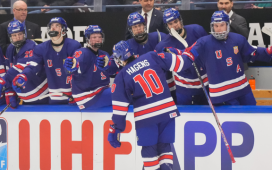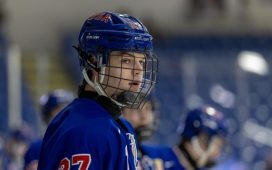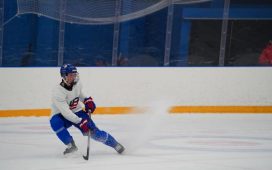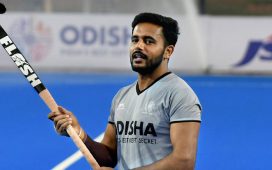Watching an NHL rookie camp is never a waste. It just might give you a life-changing idea.
It happened to E.J. Johnston a few years ago in Pittsburgh. Cranberry Township, to be exact. He was a TV executive best known for writing the NBC reality show Fashion Star, but he was a hockey guy before his foray into that world. His father, Eddie Johnston, was a retired NHL goaltender who’d spent decades in the Pittsburgh Penguins organization in his post-playing days as a GM, head coach, assistant GM and senior advisor. It was thus commonplace for E.J. to find himself hanging around the Penguins front office staff. He was sitting with his dad plus GM Jim Rutherford and then-assistant GM Bill Guerin a few years ago at the Penguins’ rookie training camp, watching the kids battle in a 3-on-3 tournament. All the players participating were unknowns, junior or college invitees on the fringe of making the NHL, but the atmosphere was electric. The sheet of ice could only accommodate a few thousand spectators, but it was packed. That’s when the idea erupted.
“I’m sort of just sitting there with Billy, just delighted with some of the unbelievable risky moves that these guys were taking, and the crowd was reacting,” Johnston said. “I talked to the scouts. I said, ‘What are you looking for?’ And the words that just kept coming out were, ‘hockey IQ, creativity, hands, vision, tic-tac-toe passing,’ all these great buzzwords coming from these guys.
“That was my lightbulb moment. This is a business. I’ve seen the crowd react to these unknown people. Imagine taking NHLers just as they finish their career at 26, 27 or 28 and played three, four, five years in the league and, for whatever reason, they’re getting pushed out of the NHL. They don’t fit in the 5-on-5 anymore, but at 3 on 3, this would be electric.”
Johnston’s brain started churning, and he went to work on a business model. He poured his own money into the idea, got his company trademarked, made himself the CEO and, before long, 3ICE was born. The league, which will debut in summer 2021, consists entirely of 3-on-3 hockey. Eight teams will compete, each equipped with rosters of six skaters and a goalie. Borrowing an idea from the XFL, 3ICE will ice a ninth team as an emergency squad from which the eight core teams can grab players in case of injuries. The eight-team field will compete in single-elimination tournaments at nine tour stops in nine cities over the course of the season. Games will consist of two eight-minute halves. At the end of the season, a final championship game will crown an official champion.
Before going all-in on the idea, the Johnstons realized they needed a face, a trusted, established hockey name that could immediately establish 3ICE as legitimate brand. They called Craig Patrick. He was U.S. hockey royalty as an assistant coach to Herb Brooks on the 1980 Miracle on Ice team and was GM of the Penguins during their Stanley Cup years of the Mario Lemieux/Jaromir Jagr era. It didn’t take much convincing.
“ ‘3-on-3? Yeah, that’s perfect,’ ” Patrick said, quoting his reaction to the pitch, as he remembers it. “It’s an exciting part of the game right now because of overtime. And I was immediately interested. We talked a little longer, and (E.J) said, ‘Would you be interested in being the commissioner?’ I said, ‘Sure.’ That was long before I knew all the time that he had spent and the group that he had put together.”
Johnston had his commissioner in Patrick but wasn’t just relying on that name to generate interest in the brand: 3ICE was already a fully formed pile of ideas.
So let’s try him. Idea 1: who exactly will compete in these 3-on-3 events? Johnston sees a sweet spot. The league wouldn’t be poaching players under existing NHL contracts. It also wouldn’t be courting players on the verge of retirement who may not have the wheels to excel with so much open ice anymore. The target group would be NHL-caliber players in their late 20s and early 30s whose style of play might be better suited to 3-on-3 than 5-on-5. An example of the body type Johnston envisions is that of current Penguin speedster Conor Sheary.
“These 5-foot-8, 5-foot-9 water bugs that are just electric in the open ice but don’t necessarily thrive in the 5-on-5 game when you have to come to the corners against 6-foot-5 players who are 240 pounds like Colton Parayko…it’s just a different game,” Johnston said. “And that water bug that sits around, he’s played the NHL for three, four, five years at 100 to 300 games under his belt, and for a host of reasons, economic or otherwise, he’s not being invited back to the NHL. But if it was 3-on-3 all the time, he’d still be there. That’s our player. This isn’t the senior tour. Our guy is that 25, 26-year-old to about 35-ish who can just motor, who can play in the open ice with his creativity, his expression, his hockey IQ on display.”
The 3ICE brass reached out to the top-end agencies, who totally understood the idea and explained that their talent rosters will always churn out year over year, pushing the fringe players out of the NHL. Not only would the league give these players a new opportunity but, because the circuit takes place in the summer, a strong showing could generate PTO opportunities for September NHL camps. Johnston anticipates 3ICE’s top annual performers will generate plenty of interest. It sounds like players are already envisioning the opportunities the league could provide, too.
“I’ve had players calling me and asking me if they would be the type of player we’re looking for,” Patrick said. “There are young guys that are either just finishing their contracts or going to be just finishing their contracts, and they’re just reaching out to see what’s really going on. “
So the players will have tremendous incentive for exposure. What about financial incentive? Well, because the league occurs in the summer, it isn’t competing with the salaries of other circuits, from the German DEL to the Swiss NLA, so that gives 3ICE an immediate edge. But Johnston insists the player compensation will be “extremely competitive.” It will include base pay but also be tied heavily to competition results. Johnston calls it the PGA Tour model. It’ll include a $3-million purse in total, including a $2-million regular-season purse and a $1-million playoff purse for the top four teams. Following Dana White’s UFC model which hands out bonuses for the knockout, submission and fight of the night, 3ICE events will award bonuses for feats like the goal and save of the night.
“If a player doesn’t win a single game, then they’ll only make X, but if you win every single week you’ll make four- or five-X, and that number will end up being more than what you’d be making in the Finnish, Swiss and Swedish league, in all likelihood,” Johnston said. “When you annualize that, we’re only the summer season, two months, and when you’d have to go to Europe for seven to eight months, it makes more (sense) for them to stay here. The top team wins roughly half that, divided amongst seven players. There’s real money there. And that’s a one-weekend competition.”
So what will that competition look like, exactly? If we’re going to get non-stop speed and skill, players will have to prepare their bodies accordingly. Think sprint, not marathon. Patrick looks back on the training the 1980 Miracle team did, which was rigorous, year-round and prepared them to skate with the Soviets. For 3Ice, the training will be about endurance given the rosters are small – but even more about speed, less about keeping fat and heavy muscle on the body and more about building lean muscle – anything that will give players an edge to get free for breakaways or, just as important, to backcheck.
The strategy will form an interesting element of on-ice play, too. Teams could roll with three forwards at all times or opt for two forwards and a defenseman. It’ll all be up to what the coaches decide – and they’ll very much be part of the spectacle. 3ICE announced this week all eight teams will be coached by former players, including six Hall of Famers: Guy Carbonneau, Grant Fuhr, Ed Johnston, John LeClair, Joe Mullen, Larry Murphy, Angela Ruggiero and Bryan Trottier. Perhaps no bench boss will be better suited to understand 3-on-3 than Fuhr, who tended goal for the most dominant offensive teams of all time: the Edmonton Oilers of the 1980s. He knew he had to be on high alert for end-to-end chances as his teammates went for all-out offense. He envisions 3ICE as ’80s-style hockey that is “just ‘go’ from minute 1 right to the very end,” and he sees the goalie’s role on the team as different than in 5-on-5.
“Obviously, you’re going to have to play more for odd-man rushes, but you also have to be able to handle the puck,” Fuhr said. “So rebound control and puckhandling will be an element we look for in a goalie more so than normal. You’re going to have to be able to handle the puck and pass the puck, because you’re going to be a part of the offense.”
The NHL’s 3-on-3 overtime format has already proven how thrilling that style of play can be, so the 3ICE decision makers are extremely confident their on-ice product will appeal a lot to fans – but the league is doubling down on entertainment anyway. Just in case the 3-on-3 isn’t enough to reel people in – there’s always a risk of hockey fatigue come summertime – the fan experience will be interactive. It’ll include ideas such as prizes for wearing costumes, the ability to vote on reseeding matchups after the first round of nightly tournaments and even the chance ‘to be Toronto,’ act as a third official and vote as goal judges on close plays. The latter idea is a complicated one given sports-betting implications, so it’s not a guarantee that fans will have the final say on those calls.
So 3ICE has the business model, the tournament setup, the target player types in mind, the big-name commish and coaches – and a place to see the games if they aren’t in your city. CBS Sports has signed on to broadcast the tournaments, as have TSN and RDS. And because the debut date isn’t until 2021, Johnston is confident the COVID-19 pandemic won’t scupper any plans for the launch. It remains to be seen when we get hockey games with fans in the stands again but, by next summer, taking in 3-on-3 events should be a welcome idea. It might be the perfect time for 3ICE to win people over.
Want more in-depth features, analysis and opinions delivered right to your mailbox? Subscribe to The Hockey News magazine.








